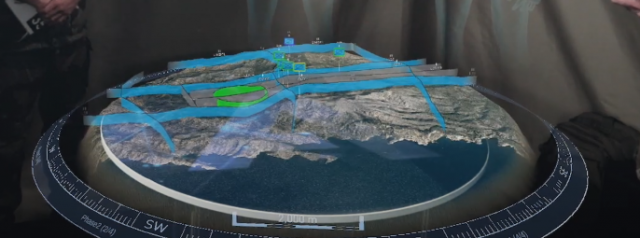AR (augmented reality) is the integration of text, graphics, audio, and other virtual enhancements with real-world objects in real-time. In the military, the use of AR has evolved significantly, proving itself to be a vital upgrade where better information can be that decisive factor in determining matters of life and death. One such use is the utilisation of AR in increasing the quality and precision of night vision by feeding the surrounding terrain into the goggles and enhancing images with silhouettes to provide better target location, distance, and depth (see Video 1). As another interesting application of AR, it might be used as an immersive 3-dimensional pre-mission sandbox to learn the terrain before heading out on a mission (see Video 2).
Game-changer
History is replete with examples of wars won with superior technology and access to information (Ahir et. al., 2020). In modern warfare, AR applications are a game-changer and a competitive advantage. The use of enhanced night-vision goggles for covert intrusions into enemy territory coupled with pre-mission terrain practice increases spatial orientation and situational awareness, thereby increasing mission success. Through these capabilities, soldiers are able to train for real-world situations without risk of injury. Battle strategies are evaluated, modified, tested and tested again in anticipation of potential issues to arrive at the best possible outcome given operational constraints. I appreciate that such AR technology has the potential to alter the course of war.
Why is it engaging?
By overlaying digital content on top of the physical world, AR technology creates a wholly immersive and lifelike experience for the user. Using the holographic tactical sandbox as an example, it can give tacticians instant information, deeper understanding of the battlefield, such as the height of the terrain, and even the ability to stage mock battles to practice combat maneuvers. This would not have been possible a decade ago, when war simulations were based on human judgment using rudimentary tools such as 2D physical maps, figurines and props. As a result, it is interesting since it expands the military’s options for what is achievable in technical warfare.
The current state of TAR and what can be improved
In determining the optimum method to use the AR, the designers of the AR-assisted night vision goggles did a thorough job of surveying their target audience and taking into account what modern soldiers are used to. For instance, the modern soldier is used to playing videogames. Thus, the designers incorporated game like designs into their visual display such as Sobel-like white lines that mimic gave avatars in videogames.

However, I believe there is room for improvements with the goggles’ visual HUD. The color and position of the clock display and compass are hard to view from the user’s perspective, as seen in the screenshot above. A potential upgrade could be to give users the option to alter the display’s positioning, on/off status, and color scheme or perhaps map elements to the hand similar to VR videogames.
For the tactical sandbox, its architecture allows for real-time communication between several parties without their physical presence being necessary. This feature considered real-world situations where not every level of military command would be present at the same location. Plans can be accepted immediately thanks to the sandbox’s ability to facilitate remote participation and expedite the chain of command.

However, one feature that may need improvement is the UI elements that represent the sandbox’s routes and enemy positions. It was difficult to distinguish the areas with intense firing from the areas with dense population. During war simulations, the ability to toggle it off or change how the routes look may be a welcomed option.
Conclusion
In conclusion, utilizing AR technology provides many advantages over the present military deployment approach. It gives soldiers better information and new strategies for gaining the upper hand tactically. While the military may not currently use much AR technology in actual missions, it will undoubtedly advance and eventually become a standard requirement in this age of technological warfare.
Citations
Ahir, K., Govani, K., Gajera, R., & Shah, M. (2020). Application on virtual reality for enhanced education learning, military training and sports. Augmented Human Research, 5(1), 1-9.
